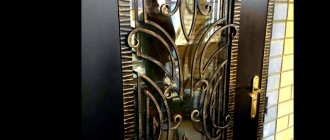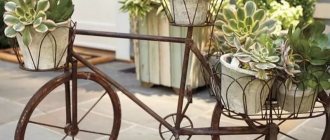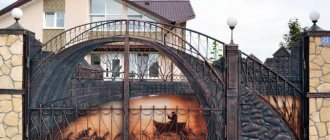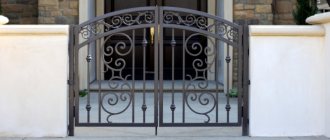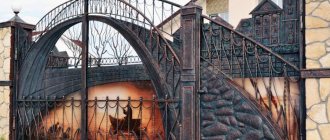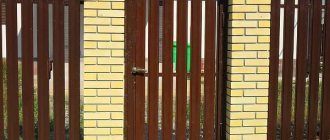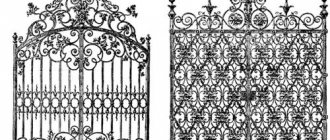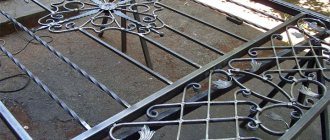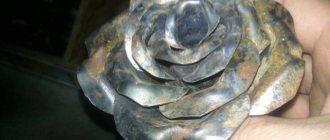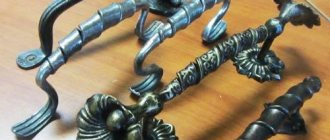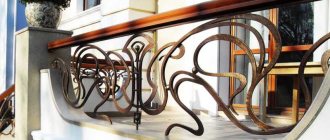Drawings on the gate leaf
A picture or drawing will help make the entrance to the site bright and unforgettable. Decor is applied using different techniques:
- Graffiti using spray cans.
- Paint drawings.
- Stenciled ornaments.
- Self-adhesive film with 3D images.
Forged patterns on metal doors
You can apply an image to any metal profile. The relief of the leaf will give it mystery. At the dacha, it is advisable to practice on the fence, depict cartoon characters, nature, flowers. Then create the best design on the gate.
Dacha owners who do not know how to draw use a plastic or cardboard stencil.
The pattern is applied with a brush or paint using a spray can.
The photo shows metal doors.
Metal patterns on the doors
Ornament on gates made of metal profiles
Patterns on metal gates, made from rolled sheets and iron rods, look original and strengthen the gates. Such ornaments increase the inaccessibility of the fence.
Corrugated sheet construction
The openwork ornament installed above and below the metal profile creates the illusion of airiness of the heavy metal structure. Elements of a contrasting tone against a background of colored fabric add volume and an aesthetic appearance. You can decorate the entrance to the site entirely or partially with your own hands. Artistic forging is mainly used:
Patterns on metal profile doors
For land owners who do not have a forging workshop, stores sell ready-made decoration elements. First, you should familiarize yourself with their assortment, and then draw up a life-size drawing of the ornament. After which you need to divide everything into simple elements and perform each one twice, if the gate is swinging and there are two leaves.
Read also: How to properly store rechargeable batteries
The pattern is laid out and welded on the ground, then attached to the canvas or to the frame. When decorating with metal ornaments, the age of the gate does not matter.
The photo shows a metal entrance group.
Decorative embossed sheet metal decoration
Decorating with forged elements made of sheet metal allows you to create three-dimensional images and even paintings. Beginners are recommended to assemble a pattern from simple elements.
For example, make a border around the perimeter of small flowers, leaves and curved stems. The petals are formed in a special die and made by embossing. The elements are connected to each other by welding and attached to the leaf panel.
Using three-dimensional forging from sheets, specialists create entire paintings that depict:
Forged patterns and embossing
Painted in golden or silver on a dark background, forged designs turn the area into a fairy tale and give the fence a luxurious look.
Photos of patterns on metal gates demonstrate the unlimited number of options and beauty of the entrance to the yard.
Leaf ornaments
A thin sheet 0.8–1 mm thick turns into an ornament in skillful hands. Small fragments of the pattern are attached in the area of loops and locks, strengthening the panel. Two-color designs create a beautiful look. The background is the gate material. The image is cut out from the sheet.
Sheet metal and forging patterns
A design is applied to thin metal, the dimensions of which coincide with the gate leaves. The holes must have a closed contour. Then everything is cut out and cleaned with a grinder and other tools. The finished decoration, made by yourself, is attached to the frame of the doors by welding or bolts.
The topic can be anything. The gates look original, decorated with trees, fantastic plants, and complex patterns. Drawings made from sheets that protrude beyond the metal profile at the top look especially unforgettable.
They make an openwork arch and a simply airy, original finish. The number of small elements depends on the owner’s ability to work with metal. The less experience the performer has, the larger the holes and the larger the radius of the part.
Gate compositions that include volumetric elements make them unforgettable.
For example, the crown of a tree, assembled from individual leaves, slightly curved near the stem. Purchased flowers and buds are suitable. The main thing is to place them correctly on the finished canvas.
The photo below shows metal doors on a summer cottage.
Metal doors with patterns
You can cut out an ornament from the strips and decorate with it individual parts of the doors, for example the bottom, or create vertical patterns on metal gates with your own hands. Located along the edge of a thin metal sheet, they will strengthen it around the perimeter.
Cold forging patterns
Forged gates are durable and beautiful. Rolled lace seems airy and light. Disadvantages of such gates:
- heavy weight;
- high price;
- transparency.
Metal doors
To prevent curious passers-by from looking into the yard, a background made of polycarbonate, plastic or metal profile is installed behind the forged ornament.
Patterns created from rods using artistic forging will decorate gates and the entire metal fence. Fragments that partially cover the canvas will reduce the cost of the fence while increasing strength.
Options for partial and complete decoration of gates can be seen in the photo below.
On metal gates in a rustic and historical style, hinges with decorative plates are appropriate. Large, with curls and rivets, they will strengthen the canvas in weak places and create an antique look.
Sketches of metal sections for DIY production
The doors look original with openwork at the bottom and top. A solid metal sheet, cut into shapes, complements the composition, while simultaneously shielding the house and yard from the curious. Separate elements are located against the background of the metal profile. The ornament outside the background demonstrates its openwork.
Read also: How is steel produced?
Metal fence with polycarbonate
The luxurious image of the gate is created from three-dimensional ornaments painted in different tones. The main interweaving of black vines and golden flowers will not leave anyone passing by indifferent. Photography is not able to convey the volume and play of shapes of such patterns, their charm.
In addition to the contrast of colors, the play of shadows from the relief elements of the decor is very organic.
Sketch for making sashes with your own hands
Not only a blacksmith can create fairy-tale gates by decorating them with ornaments from forged fragments. It is enough to buy all the necessary elements. The parts, laid out in the drawing in full size, are welded at the points of contact. After cleaning and painting, the ornament is attached to the canvas or sash frame.
The photo shows a metal structure with patterns.
At the summer cottage
Types of gates
There are two main common types:
- Swing.
- Recoil.
They open manually or automatically. Sliding and garage options are also installed.
A beautiful option for a private home
Wrought iron gates have two types of construction:
- Open (direct frame, grilles with openwork patterns, rods).
- Closed (sheet, frame, fixed forging elements).
Recoil
Sliding gates with a wicket are often installed to save land space. The canvas opens to the side along the fence (side wall). The rolling canvas is moved back with the help of special rollers (on which it rides).
Automation can be installed on swing and sliding gates. Using the remote control, you can easily control the opening/closing of the doors. This is convenient for frequent trips by car (there is no need to constantly get out of it).
Retractable design
Swing
A practical choice is swing doors. Clients choose them most often. It is very convenient to use forged swing gates: they do not take up extra space.
They are suitable for any decorative decorations that are combined with various materials. They are complemented by molded details placed on the doors, which give charm, add volume, and complicate the ensemble.
The shape is varied (rectangular, triangular, wavy, arched, zigzag).
Swing gates are a classic forged version of the gate. The shutters swing open. Affordable price. They last quite a long time.
In combination with corrugated sheets
The swing structure has two doors that open both inside and outside the courtyard. The mounting is simple, you can install it yourself. You just need to attach the doors using hinges (they support the entire weight of the product structure) to pre-installed fence posts (supporting ones).
These posts must be of suitable size and weight (consider the weight and size of the wrought iron doors to calculate suitable supports).
The pillars are concreted at least 1 m deep. If the soil is unstable - more than 1.5 m. It is even better to connect the two supports with a concrete strip underground (under the gate itself). This method will prevent the columns from moving in the future. Also for this purpose, a connecting jumper is made above the gate itself.
Combination of materials
Sliding
Another frequently installed option is sliding gates. They are used not only as entrance gates, but also for garages, homes, and offices.
These are the same wrought iron sliding gates. They are especially relevant in areas with dense buildings (they do not require additional space to open the doors). This is a fence that can operate automatically.
The most popular are sliding cantilever doors. They take up very little space and open in any direction (right, left). Reliable, easy to use. To increase comfort, a gate is installed on them.
Massive construction
Advantages
The design has the following advantages:
- high security (they are not easy to open);
- strength;
- good load-bearing capacity;
- save time, especially in winter (there is no need to clear away all the snow that has fallen, they will open anyway).
Flaws
Among the disadvantages are:
- they cannot boast of a built-in gate (it will have to be additionally installed - this is a costly affair, takes time, takes energy);
- the need for individual selection of sections (if you buy ready-made ones, you need to calculate the weight of the product to select the appropriate ones. Usually stores offer standard options);
- occupy a place near the fence.
Wooden structure
To completely neutralize shortcomings, you will need desire, strength, and financial investments.
Garage
Forged garage doors are a reliable rear. Making them with your own hands will require some tinkering. But you will receive reliable protection with unrivaled decor. This option is especially suitable if you have a very expensive car: you will save yourself from unnecessary worries.
You can make wrought iron gates yourself. There are different types of them. If you are just a beginner blacksmith, stop at a simple task - a simple option, which you decorate with forging elements (forge carefully, slowly). Such gates will already be distinguished by artistic beauty.
Forging will fit into any style, even the most modern. But it is better to combine it with the style of the house, its shade, and other buildings located on the territory.
Option with brick pillars
Patterns on the gate
The gate is a mandatory element of the fence. The gate will look unfinished without decoration with similar patterns, using the same technology.
Patterns on the gate
The same details are used to design a metal gate. They repeat the main fragments of the pattern on the doors, only in a reduced form, taking into account the size of the canvas. All elements of the entry group should look like a single whole.
When decorating a fence with cold forging, the ornament is laid out from parts according to the size of the gate frame. With structures rounded at the top, a semi-arch is made, with the high side directed towards the gate.
The sheet metal pattern has its own characteristics. The gate has its own image, to which a design is added on the doors. For example, there is a large oak tree on the gate, and a small one next to it.
The paint and graffiti done on the gate continues on the gate. The fence in which the fence is a continuation or repetition of the picture of the entrance group looks original.
Film with a 3D image is glued in the same way. Designers advise taking a wide film, cutting it and gluing it in fragments to each element of the entrance group.
The photo shows a metal profile gate.
Metal gates with patterns and pictures of various types create an atmosphere of comfort on the site. They emphasize the good taste of the owner and his wealth.
Builder 4th category
The profession of a blacksmith is one of the most ancient. As soon as a person learned to mine iron, he immediately began to process it with the help of fire and a hammer. Nobody knows when the first forged patterns appeared. Fabulous iron ornaments on the facades of houses and their fences have enchanted the eye for many centuries. The modern history of artistic forging continues to develop rapidly. Metal products are still in demand.
There are several types of such forging
Specifics of self-manufacturing entrance structure
Drawing up a drawing
A gate with forging elements consists of many details that need to be depicted in a sketch. The drawing must include the dimensions of the structure, main and decorative elements drawn to scale. The standard height of the product is 1.5 m, width is 1 m, minimum distance from the ground is 10 cm.
The structure consists of:
- supports;
- frame made of corrugated pipe with a section of 30x20 mm;
- awnings;
- patterns;
- locks, latches.
Tools needed to build a forged gate with your own hands:
- anvil;
- bugle;
- sander;
- vice;
- welding;
- machines “Torsion”, “Ex;
- Bulgarian;
- mites;
- hammer;
- stitching for forming holes.
Installation of pillars
Since a forged gate is heavy, it is better to install metal supports for it. These can be round or profile pipes. To ensure the stability of the structure, they are deepened into the ground by at least 1 m and secured by concreting.
Frame construction
The basis of the gate is the frame, which is the basis for the arrangement of decorative parts of the structure. It has the shape of a rectangle and is made by welding a frame of four profiles with a cross-section of 30x20 mm. First, they are welded on top and sides, then the seams are welded, and then the arc is cut.
Manufacturing of decorative parts
Artistic forging of gates is carried out sequentially, by manufacturing individual elements. The patterns are formed from reinforcement rods, cut into the required lengths.
The blank is heated to 300˚C, and then brought to the maximum temperature in the oven. After this, the part is compacted with hammer blows, rolling it in a circle. During this procedure, scale is removed and the elements are given the desired shape.
Assembly of the structure
When the decorative elements are ready, they should be fixed to the frame
It is important to observe the principle of symmetry. First, they are laid out on the canvas, forming a certain pattern.
Then the parts are connected to the base using small tack welding. It is done so that the seams remain on the inside of the gate.
Hanging, decorating the product
All that remains is to install the finished structure on the supports. To do this, it is best to use point canopies that are welded to the pillars and frame of the structure. Additionally, the product is equipped with a latch/lock.
When the welds have cooled, they are cleaned and ground. After this, they begin painting the product. Its surface is degreased, primed, and covered with a coloring compound or patina.
Beautiful forged gates allow any area to be given a solid, respectable look. They emphasize the good taste of the owners and their status. It is not at all necessary to spend a huge amount to order such a product. With basic skills in working with metal, such a design will not cost much.
Types of artistic forging
There are two main methods of metal processing:
The classic method of metal processing is, of course, hot forging. It has long been noted that when heated, iron becomes soft and easily deformed, but when cooled it retains its given shape.
The undoubted advantage of this method is the great possibilities of forming the material . The disadvantages include high energy consumption and the practical impossibility of doing this business without a specially equipped forge.
In this video you will learn more about the types of forging:
Cold forging has recently become very popular. The main advantage of this method is its accessibility and the ability to practice at minimal financial cost. To do this, it is enough to have good tools and a small workshop or space in the garage.
Cold processing also requires less time. There is practically no need to finalize the product to a marketable state, but with hot forging this procedure takes a lot of time and effort.
Read also: Stand for repairing ball joints
Disadvantages include limited decorative and artistic techniques and the fact that this method requires good physical training and the acquisition or manufacture of special tools.
Artistic and cold forging, elite and inexpensive options
Cold forging ensures the production of products with the following characteristics: patterned design and reasonable cost. Such projects are implemented in the shortest possible time, since special equipment is used for their production.
Forged lattice door. Photo Hovhannisyan Eduard (Art-Fe - artistic forging)
Hot forging allows you to create products that are unique in design and expensive in cost. Manual metal processing requires a significant investment of time to complete the project.
Each product category has its own pros and cons. Therefore, each client decides which option to choose independently.
Basic patterns
Since iron can change shape during heat and physical treatment, there are various examples of forged patterns. All of them can be divided into three main groups:
Undoubtedly, the most popular of them are floral forged ornaments. The artful interweaving of branches, flowers and leaves has always inspired artists to create fantastic works. Blacksmiths are no exception in this series. They also often use plant motifs in their work.
For cold working, metal rods are most often used as the main material. They are bent, twisted, flattened, minted, milled and forged. The end result is magnificent works. Here are the main elements and techniques for this type of metal work:
- Curls. The most popular element. It has a huge number of different options and modifications.
- Spirals. Single, double, spatial and others. This is also a very popular technique that makes patterns for forged products memorable and original.
- Cool. Twisting iron bars can be the most incredible experience. The imagination of some authors is amazing.
- Top. A decorative insert or special atypical treatment of the ends of the rods can greatly diversify and decorate any ornament.
- Coinage. The use of chisels and hammers for decorative inserts in forging patterns is a long-proven and often used way to add creativity to a future creation.
- Headings. Cylindrical, cone-shaped, spherical elements made of rolled metal, attached to the end of a rod.
These are not all the techniques in the arsenal of a good master. By skillfully combining them, craftsmen create real masterpieces from ordinary iron.
Assembly techniques
Any creative process begins with sketches of the future work. The work of a blacksmith is no exception. Forging begins with drawing patterns. Then suitable material is selected, and the plan is brought to life.
Most often, real metal wizards first make all the parts separately. After all the patterns for forged products are embodied in the material, they are assembled into a single whole. To do this, one or more basic assembly methods are used:
- Folding. This method joins adjacent edges by twisting them together.
- Welding. The modern connection method is in great demand today and is used quite often.
- Double bend. The connection is made by bending one edge and using the other as a decoration.
- Coining. The parts are connected by pressing part of one of them into the other.
In addition to these techniques, some authors also use metalworking methods of connection using ordinary bolts and nuts. Some people use rivets and other methods, even twisting individual parts with wire.
Whatever the author's decision, metal products are usually very beautiful. A decorative lattice in a fence or a forged candlestick, if they are in their place, will delight you with their beautiful appearance for a very long time. That is why forged products always enjoy deserved popularity.
